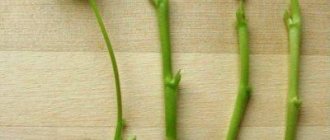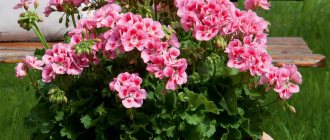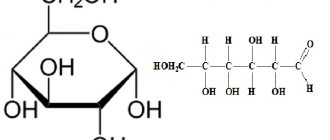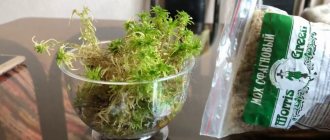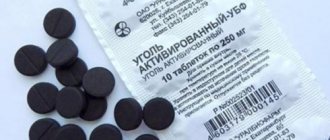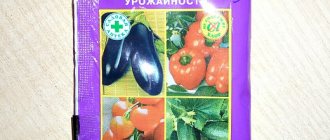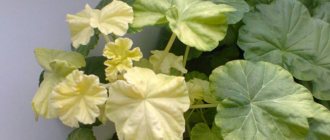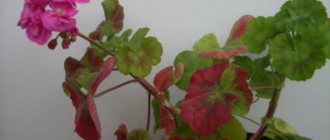What is geranium iodine for?
The number of flowers will increase if you feed the plant with magnesium sulfate a couple of times during the summer.
But most gardeners choose a different method. They mix two components: regular iodine purchased at the pharmacy and hydrogen peroxide. With a solution of three elements (the third is water), geraniums that are weakened or do not want to bloom are watered once every 7 days.
The described solution is very useful for indoor flowers. It significantly strengthens the root system. Strong roots provide the plant with nutrition, which is immediately visible: the leaves become larger and their color is brighter.
It is impossible not to notice how the appearance of the flower changes:
- its colors are saturated;
- the appearance of ovaries accelerates;
- the number of buds increases;
- flowers become larger;
- the flowering period is extended.
Like real “living water”, the mixture works wonders. It destroys bacteria that appear on the plant, helps to overcome diseases, and protects the root system from rotting. A flower fertilized with iodine is transformed, showing all its advantages, all the brightness of its colors, all its tenderness and irresistibility.
You should not use this fertilizer too often. If the plant is doing well, you can be content with regular watering.
How to fertilize geranium seedlings and young plants for growth
The first fertilization of seedlings is carried out at the age of 14-18 days. The use of active vermicompost from the Planta series at this stage of development will help the geranium to form correctly. Application to the soil should be carried out once a week. Before transplanting the plant into a new container, picking is carried out.
After the adaptation period, the soil is enriched with saltpeter and Kemira fertilizer. This fertilizing is also applied once every 7 days.
Kemira luxury
How to prepare fertilizer?
Medical iodine is used as plant fertilizer - an alcohol solution of iodine 5%. The recipe for preparing the solution is simple: add one drop of iodine to a liter of water and mix thoroughly. It is advisable to use settled or rainwater.
Iodine cannot be used in its pure form for watering geraniums. For very weakened flowers, you can increase the iodine concentration to 3 drops.
Watering
Here's how to properly water a flower:
- Prepare the solution.
- Water the soil with plain water.
- About an hour after the water has soaked into the soil, gradually pour in the iodine solution.
Pour the iodine solution as close to the side wall of the pot as possible. On average, one flower pot requires 50 ml of solution.
Frequent fertilizing with iodine can damage the root system. It is advisable to carry out such watering no more than once a month. if something went wrong...
Iodine fertilizer often ends up on the foliage of the plant.
If you do not pay attention to this and do not take action, the leaves will wither and dry out.
Attention! If a solution with iodine gets on the leaves, you must immediately remove it with a soft cloth.
An excess of iodine can negatively affect the indoor beauty - lead to its violent flowering and the appearance of yellow buds and leaves.
Even novice gardeners can achieve abundant and beautiful flowering of geraniums.
It is important not to forget about feeding the plant. Such a valuable microelement as iodine is an excellent activator of the life processes of indoor plants
But it is worth remembering that the flower requires not only watering with a solution of iodine, but also fertilizing with mineral fertilizers.
Do you want to learn more about growing geraniums at home and in the open ground? Read articles from our experts on how to properly trim and pinch a plant, how to choose soil and pot, and also learn tips for caring for a flower in the winter.
How to care?
Flowers in the house are wonderful, but plants require proper care to bloom profusely. Geraniums need to be watered regularly and periodically added fertilizer to the soil. The plant will delight you with bright greenery, lush flowering and a delicate aroma if its owner fulfills a number of simple conditions.
The place chosen for pelargonium should be warm and bright. A window sill on the southwest side will be just right. It is better to make sure that in hot weather direct sunlight does not fall on the flower and does not burn the foliage and delicate petals. In addition, pelargonium requires space, so neighboring pots with indoor flowers should be placed at some distance from it.
Pots for geraniums are medium-sized with holes in the bottom. First, drainage is placed in the planting container. Soil consisting of peat, sand and garden soil is poured onto a thick drainage layer. A depression is made in the moistened soil, into which the root system of the flower is placed and pressed tightly. In summer, watering is done more often, in winter - less often . The soil in the pot should not dry out. Excess moisture is also contraindicated.
For better passage of oxygen, loosening is performed.
In order for the plant to receive the necessary substances, it must be fertilized. In winter, as a rule, fertilizing is not done. Another thing is spring and summer.
Description of the plant
This is an annual and perennial plant.
The height of the stems reaches 50 cm. The leaves are bright dark green. The flowers of the plant are very beautiful and large. In some types of geraniums they are collected in inflorescences. The leaves of the plant have a refreshing, mint and lemon aroma. The leaves have a pattern, presented in the form of a white border or stripes of various colors. Geranium is distinguished by incredibly beautiful flowering. Umbrellas of flowers are concentrated on a thin stem, and the leaves look like a human palm. If there is not enough lighting for geraniums, then its flowering decreases, and the leaves and flowers become faded.
Types of indoor geranium
The most popular and beautiful types of indoor geranium:
- The most common is Geranium zonalis (bordered, kalachik). There are 70 thousand varieties. The leaves are entire, with dark concentric circles of varying intensity. The stem is erect; if formed incorrectly, it grows up to 1 m in height. The flowers are bright, pink or white, simple, semi-double or double in shape.
- Ivy differs from the zonal shape of the stem. Long vines, decorated with smooth leaves, hang down. The flower is installed in hanging flowerpots.
- The royal one grows up to half a meter. The leaves are plain or have stripes and dark spots. The flowers are large, simple or double in shape, monochromatic, of various colors, with colored spots, veins, and borders. Another name is English grandiflora.
- Fragrant geranium can have the smells of lemon, pine needles, lemon balm, ginger, pineapple and other plants. The Strong-smelling variety has the aroma of a rose, the Most Fragrant variety has the aroma of an apple. Some scents are not very pleasant. The flowers are inconspicuous, pink or purple. The bush needs to be pinched regularly so that it has a beautiful shape. Used for the production of aromatic oils.
- Geranium Angel with viola-like flowers. The bush is ampelous, the vines are shorter than those of the ivy leaf, covered with inflorescences with a large number of flowers.
Unicuma hybrids have highly dissected, very fragrant leaves. The flowers are large and beautiful, but smaller than those of the Royal one. Miniature and dwarf varieties do not require pruning. They bloom profusely.
Tips for the garden, vegetable garden and flower garden
Why are there a lot of barren flowers on cucumbers: what to do?
Why are there empty flowers on zucchini: what to do?
Mulching with sawdust: pros and cons
Based on the shape of the flower, several groups of zonal geraniums can be distinguished:
- Rosaceae with flowers resembling roses.
- Cactus-shaped with petals twisted in the shape of a cone.
- Star-shaped with pointed petals.
- A group of carnation flowers with petals serrated along the edges stands out.
- Succulents are a special type of geranium. The stems of the plants are intricately curved. Some varieties have thorns.
What fertilizers are needed for lush flowering of geraniums?
For abundant flowering, pelargonium needs to be fed with mineral fertilizers. One-component fertilizers required:
Nitrogen promotes the growth of the vegetative part of the plant - stem, leaves, roots. It is used in the first months of spring. Phosphorus is required for the formation of buds. Its lack slows down the process. Potassium increases endurance. With its deficiency, growth stops.
When the buds open, reduce the amount of nitrogen and increase the amount of potassium. You can also use complex fertilizers, which contain many minerals. Benefits for geranium:
These minerals are an additional source of strength for its good growth. Thanks to sulfur and magnesium, it will bloom regularly. All substances should be applied in accordance with the attached instructions. Iodine is one of the most necessary elements for pelargonium. It is necessary for lush flowering.
Tips for gardeners:
- Fertilizers in liquid form can only be used after watering, as there is a risk of burning the roots of the plant.
- After adding minerals, the soil under the flower needs to be loosened.
- Pelargonium cannot be fed 2 weeks before transplantation and 1 week after.
- The flower has buds - it cannot be disturbed or moved to another place. This will be stressful for her.
- Sick pelargoniums cannot be fertilized.
There are many ways to feed geraniums at home. The two most famous:
- with the addition of iodine, peroxide;
- using pharmaceutical vitamins.
Feeding with iodine and peroxide
Regular iodine from a medicine cabinet can cause vigorous flowering of pelargonium. The process does not take much time, but gives good results. After such fertilizer, the effect can be noticed after 2 – 3 procedures.
How to water geraniums with iodine:
- It is necessary to moisten the soil in the pot.
- It is necessary to make a solution. Proportions – 1 drop of iodine per 1 liter of water. You can add 1 ml of hydrogen peroxide to this solution.
- Watering - along the edges of the walls of the container. Avoid getting liquid on the leaves. For 1 procedure, you can use 50 g of solution.
- The number of feedings is 1 time every 3 weeks. Frequent use is not recommended - it causes damage to the roots.
- Time: May - September. This must be done extremely carefully. Excessive amounts of solution components can burn the roots of the flower.
Video: How to feed geraniums with iodine
The water for preparing folk feeding must be settled. Rainwater is ideal.
Vitamins
Fertilizer for geraniums so that they bloom can be purchased at the pharmacy. In addition to iodine, geraniums use B vitamins - B1, B6, B12. This is a folk remedy, one of the budget methods.
In the first months of spring, it needs nitrogen. Vitamins begin to be used closer to June. For one time use 1 ampoule of vitamin per 2 liters of water. Water the flower abundantly. Vitamins are changed every 3 weeks. Pelargonium can bloom well without fertilizers. The main thing is not to overdo it. Excessive amounts of added substances can destroy it. This feeding of pelargonium gives it the opportunity to bloom profusely and strengthens the plant’s defenses.
Organic feeding
Fertilizing of animal or plant origin for geranium is required once every 3 years. If the question arises about how to feed geranium to bloom better, you should give preference to mineral substances.
In order for the geranium to bloom magnificently, you can water it with well-fermented bird droppings (1 liter per 2 buckets of water), cow manure (1 liter per 1 bucket of water). It is not recommended to use fresh manure.
If you have a choice between chicken manure and mullein, it is better to choose the second option - it is more gentle. Lush flowering of geranium is ensured by mineral substances. Almost no organic matter is required.
At the beginning of May, nitrogen is added to the soil, and at the end - complex fertilizers for flowering plants. They use vitamins and increase the volume of potassium and phosphorus fertilizers.
It can tolerate mild drought. But excess moisture will destroy it. Feeding period: March – September. The soil must be moist. At the time of illness, if the plant has stood in the sun for a long time, fertilizers cannot be applied.
Hello, dear readers! I am the creator of the Fertilizers.NET project. I am glad to see each of you on its pages. I hope the information from the article was useful. Always open to communication - comments, suggestions, what else you want to see on the site, and even criticism, you can write to me on VKontakte, Instagram or Facebook (round icons below). Peace and happiness to everyone!
Key points to note
Pelargonium, like any other flower, loves some things and doesn’t like others. For example, it grows well in the sun. A light shadow is not a problem for her. She is able to survive slight autumn frosts, but at the same time she loves warmth very much. It needs rare but abundant watering. It cannot do without good drainage in the container where it is planted. If the soil is poor, there will be fewer flowers. Otherwise, there will be a lot of green on the sprout. It cannot do without fertilizer. Do not forget about such a drug as iodine.
In order for the sprout to bloom better, remove the inflorescences that have faded. When fertilizing, be careful. So, without causing harm, you can promote good growth of pelargonium. By following these simple rules, you can ensure a long life for your favorite house flower. This way you can enjoy its flowering for a very long time. This will create a pleasant, cozy atmosphere in your home. After all, beautiful flowers always decorate the interior.
Essential Vitamins and Minerals for Geranium Growth
Pelargonium, like any other house flower, receives all the nutrients it needs for its life from the soil.
In order for geranium to bloom long and beautifully, the soil must contain the following microelements:
- manganese;
- nitrogen;
- boron;
- potassium;
- copper;
- calcium;
- zinc;
- iron;
- phosphorus.
If the soil is depleted of at least one microelement, then the flower will exhibit various deviations in flowering until it stops completely. In addition to the substances described above, pelargonium needs B vitamins for abundant flowering. It is worth noting that simple feeding is not enough to start flowering of pelargonium. The flower must grow in optimal conditions for itself. The pot should be placed on a sunny and open area of the windowsill. Watering pelargonium should be rare but plentiful.
And a little about the author’s secrets
Have you ever experienced unbearable joint pain? And you know firsthand what it is:
- inability to move easily and comfortably;
- discomfort when going up and down stairs;
- unpleasant crunching, clicking not of your own accord;
- pain during or after exercise;
- inflammation in the joints and swelling;
- causeless and sometimes unbearable aching pain in the joints...
Now answer the question: are you satisfied with this? Can such pain be tolerated? How much money have you already wasted on ineffective treatment? That's right - it's time to end this! Do you agree? That is why we decided to publish an exclusive interview with Oleg Gazmanov, in which he revealed the secrets of getting rid of joint pain, arthritis and arthrosis.
Attention, TODAY only!
You can grow geranium from seeds, but I prefer cuttings, which are carried out from mid-February to early March. At this time, it is already necessary to prune geraniums.
After all, geranium is light-loving, but in winter there is little light, and the plant stretches out and becomes not very beautiful. In geraniums you need to trim the bare shoots to the height you need, new branches will come from them.
A drop of iodine - and you won’t recognize your geranium!
Or you can renew geraniums every year by replanting them from new cuttings, as our great-grandmothers did in the old days. For propagation of geraniums, apical cuttings approximately 7 cm long with three or five leaves are suitable.
We cut the cuttings, making an oblique cut under the bud, tear off the lower pair of leaves, dry the cut and the place where the leaves are broken for 2 - 3 hours, so that the cut is covered with a film, and plant immediately in prepared pots with soil, water lightly.
To form a lush bush, we pinch the apical bud. We put it in a bright place, but not in the sun.
Many people simply cut the cuttings and place them in water; I advise you to put activated carbon tablets in a jar of water to prevent rotting. Roots form very quickly. Then they are planted in pots.
You need to take a small pot. Geraniums don’t need a lot of soil. The faster the roots entwine a clod of earth, the faster the plant will bloom, and the smaller the pot, the more abundant the flowering will be. In large pots, the plant may not bloom at all, it doesn’t need it - life is already good, why bother? You can even plant several cuttings in one pot.
To form a beautiful lush bush, pinch the top on the 8-10th leaf, the side shoots on the 6-8th and constantly turn the pot so that the bush is even.
Geranium loves:
- sun (but tolerates light shade);
— warm (but will survive very light autumn frosts);
- not frequent, but abundant watering;
- good drainage in the pot;
- moderately fertile, even poor soil (otherwise there will be a lot of greenery, but few flowers);
- regular feeding;
- removing faded inflorescences to continue flowering.
A very good feeding is iodine water: dissolve 1 drop of iodine in 1 liter of water and pour 50 ml of this composition over the walls of the pot. Don't overdo it so you don't burn the roots! After such watering, the geranium blooms continuously and gorgeously!
If the leaves turn yellow, the reasons may be as follows:
- if only the edges of the leaves dry out, the cause is lack of moisture;
- if the leaves are limp or rotting, the reason is excess moisture.
In summer, geranium loves to live in the fresh air - take it out onto the balcony or into the garden and plant it well in the ground. At first, having experienced the stress associated with a change of place, the geranium will hurt, its leaves may turn yellow and fall off. But then she will delight you with abundant flowering.
The geranium blooms amazingly outside, and the bush grows strongly like never at home. In the sun, sometimes geranium leaves turn pink - this is a normal phenomenon, like a “tan”, the plant is no better or worse from this.
In autumn, when the weather is cool at 10-12 degrees, geraniums “go crazy” from this temperature!
You can keep geraniums outside until frost begins, until the temperature drops to +2 -5 degrees. Then it will need to be cut, transplanted into pots and placed in a cool place (10-12 degrees) for winter hibernation or, gradually accustoming it to higher temperatures, brought into a room where it will continue to bloom.
Pinching and pruning geraniums at home
How to properly pinch pelargonium at home
Pinching (pinching) is the removal of the top part of a plant with young shoots. At the same time, apical growth slows down and branching of the lower lateral shoots is stimulated. Pinching is done with clean fingers.
You need to pinch the plant from the very beginning of its development.
Particularly important for geraniums grown from seeds
Pinching pelargonium
It is done in several stages.
First you need to pin the apical bud of the main shoot above the stem node. The lateral buds located below awaken after this procedure and begin to grow and lengthen.
The next stage is pinching the tops of the ivy-leaved side shoots until the bush takes the desired shape. If you do not do all this at the very beginning of the plant’s growth, then there is a high probability of getting an ugly plant with a long bare stem and a small number of flowers located at the very top.
It is geranium that differs from many flowers in that it produces lateral shoots after the forced awakening of dormant buds into the node, if forced.
How to prune to form lush flowering and fluffy crown?
Pruning is the removal of part of the shoots that have stem nodes.
Autumn pruning is carried out at the end of the growth period. This condition allows the formation of a lush and fluffy crown.
If the flowers were outside in the summer, then they need to be brought into the house before cutting off the indoor pelargonium. Make sanitary pruning, removing damaged, diseased shoots. To ensure good ventilation, shoots directed into the crown should be cut, and the stems should be shortened by a third.
To ensure that the shoots do not interfere with each other after waking up, you need to prepare them and cut them at an angle above the leaf node, which is located outward. A clean, sharp knife or blade is suitable for these purposes.
In winter, geraniums have a dormant period. Frequent watering is reduced and fertilizing is stopped completely. The air temperature should be no more than 10-12 degrees. Water and feed according to recommendations.
Spring pruning comes down to the final formation of the bush. You can start it at the end of February or at the beginning of March. At this time, the active growing season begins. If you are late, the flowering period will be delayed.
Why apply fertilizer?
Feeding is an important process when growing a plant, thanks to which it is saturated with useful components for active growth and flowering.
When applying fertilizing, the season is taken into account:
- in spring and summer, fertilizer is applied once every 2 weeks;
- in winter - do not use fertilizing (it is allowed to add only ½ of the usual dose of stimulants in the middle of the winter months).
Important! The choice of drugs must be taken carefully. The fact is that geranium will not tolerate organic matter.
For its flowering, mineral fertilizers are used, the main ones of which are nitrogen, phosphorus and potassium.
They must be applied in equal proportions, but by the beginning of flowering the dosage of nitrogen decreases, but the concentration of potassium increases.
If it is impossible to apply fertilizers separately, then you should use ready-made mineral subcrusts. They contain additional minerals
Particular attention should be paid to iodine, to which the plant responds with abundant flowering.
You should not apply liquid fertilizers without first watering the soil. Otherwise, the roots will get burned and die. Fertilizers for geraniums must be applied an hour after the main moistening.
When should you feed?
Before you begin fertilizing and considering possible methods, it is worth determining when the plant needs it. This can be determined by the features that are noticeable in their complex manifestation.
If geranium becomes vulnerable to disease, then this is the first signal that it does not have enough nutritional minerals in the soil. Because of this, the flower often gets sick, as there is a lack of nutrients in the body.
But here it is important not to overdo it with feeding. It is unacceptable to apply it too often for geraniums.
You can determine the lack of nutrients by looking at the leaves. They become lethargic, pale, and their growth slows down. If a flower is affected by disease, the leaves begin to dry out. In severe cases of the disease, the leaves fall off.
Geranium will bloom only if two important conditions are met:
- correctly selected temperature mode;
- feeding that contains all the necessary nutrients.
If these conditions are not met, the crop will not bloom for years. There are no buds on geraniums if they are fed incorrectly. In spring, apply fertilizer every 2 weeks, and in summer and autumn - once a month. Before applying fertilizing, you need to water the soil. This will prevent the development of burns on the roots.
You can find out more about when to use fertilizers and what is the best way to feed them here.
What can you use?
Attention. When choosing a fertilizer, you need to take into account that during specific periods of geranium development, different concentrations of minerals in the composition of fertilizing are necessary. If at the beginning of spring the proportions of nitrogen, phosphorus and potassium can be equal, then after the growth of green mass the percentage of nitrogen is minimal
During this period, it is necessary to use fertilizers containing potassium and phosphorus, which affect flowering
If at the beginning of spring the proportions of nitrogen, phosphorus and potassium may be equal, then after the growth of green mass the percentage of nitrogen is minimal. During this period, it is necessary to use fertilizers containing potassium and phosphorus, which affect flowering.
The next important microelement that is necessary for abundant flowering of geraniums is magnesium sulfate. It is necessary to apply it 2-3 times in the summer so that the flowers acquire a rich color, the number of buds increases, and the flowering period extends.
To stimulate the growth of the crop, you can water it once a week with an iodine solution (1-2 drops per 1 liter of water). The components contained in iodine strengthen the root system, and this has a positive effect on the appearance of geraniums.
You can learn more about how to feed geraniums for lush flowering in this material.
How to prepare and use iodine supplement for vigorous flowering of geraniums?
The incredible popularity of geranium can easily be explained by its ease of care, long flowering time and rich coloring. By following the basic rules, you can enjoy the fabulous flowering of this homemade beauty from early spring days until late winter.
Fertilizing plays an important role in plant care. For example, fertilizing a crop with regular iodine stimulates abundant flowering. How to prepare fertilizer with iodine to feed geraniums and water them correctly? The answers follow.
The importance of proper fertilizer
The right choice of fertilizer for pelargonium is the key to a healthy plant and abundant flowering. Organic fertilizers solve some problems.
Pelargonium needs a complex of minerals such as potassium, nitrogen and phosphorus. The proportion of nitrogen is reduced closer to the flowering period with a simultaneous increase in the amount of potassium. Pelargonium responds well to the addition of iodine before flowering.
When and in what cases is feeding required?
In winter, pelargonium hibernates. For this reason, it does not require additional nutrition. They begin to apply fertilizers in the spring and continue throughout the summer. Applying complex fertilizers 2 times a month will provide the plant with nutrients in full.
Important! Applying fertilizers before watering is prohibited. The roots of the flower will get burned and die
Fertilizer is added after watering one hour later.
Situations in which fertilizing is not carried out:
- in case of flower disease;
- after prolonged exposure to the sun;
- 2 weeks before and a week after the transplant.
What and how to fertilize?
The main purpose of feeding the plant is lush and long-lasting flowering. The use of nitrate, phosphate, potassium and iodine-containing substances will help achieve the goal.
A comprehensive nutritional “diet” includes:
- iron supplements;
- sulfur;
- potassium permanganate;
- magnesium-containing substances;
- calcium.
Ready-made formulations
Fertilizers in finished form are found in dry and liquid form. Preparations from Pokon are popular among flower growers.
When used, the growth and flowering of pelargonium is accelerated. You should not be overzealous with fertilizers that contain a large proportion of nitrogen.
This will lead to abundant foliage growth and the formation of powerful shoots, preventing the onset of the flowering process.
Hydrogen peroxide
Monthly use of hydrogen peroxide:
- disinfects the soil;
- prevents root rotting;
- saturates the soil with oxygen;
- accelerates the formation of buds.
Reference! Dissolve 50 ml of the drug in 2 liters of water. The mixture is used for watering and spraying pelargonium.
Boric acid
The drug will help increase the chlorophyll content in pelargonium and stimulate the flowering process. Fertilizing is carried out during the active growth phase at the rate of 10 g of boric acid per 10 liters of water with the addition of 1 cup of ash.
Formula milk
Adjustment of the volume of pelargonium flowering is carried out by alternating watering with plain water and a milk solution. Prepare a solution of 1/2 cup milk and 1 liter of warm water.
Sugar
Pelargonium responds positively to feeding with sugar. Applying a sugar solution in winter will cause the plant to bloom. The frequency of feeding with sugar is once a week. To obtain a sugar solution, take 2 tablespoons of sugar per 1 liter of water.
Ash
Adding ash disinfects the soil and forms beautiful buds. Top dressing is prepared from 40 grams of ash and 1 liter of water. The frequency of “feeding” is once every two weeks.
Yeast
Dry yeast is diluted in warm water at the rate of 1 gram of the drug, 20 grams of sugar and 1 liter of water. After the start of fermentation, dilute with water in a ratio of 1:5. This feeding will form massive and healthy pelargonium.
Important! Fertilize only in spring. No more than 2 times per season.
What to feed for abundant flowering?
Abundant flowering is promoted by the application of mineral fertilizers:
- nitrogen;
- potash;
- phosphorus;
- iodine
Options for nutrient mixtures to obtain lush and long-lasting flowering:
- Wood ash and water. A solution of 20 grams of ash and 1 liter of warm water will increase the number of buds.
- B vitamins. An increase in the number of buds when using vitamins is achieved by alternating fertilizing:
- the first using B1;
three weeks later, the second - B6;
- three weeks later the third was B12.
- Magnesium sulfate solution. Dissolve 1.5 tablespoons of the drug in 10 liters of water.
Prepare a solution from 1 ampoule of vitamin and 1 liter of water. The composition is watered along the edge of the pot, around the root system.
Iodine
Iodine can ensure vigorous flowering of pelargoniums. Using regular pharmacy iodine will not take much time, and the result will be good. The effect of iodine supplementation is noticeable after 2-3 applications.
Algorithm for using iodine for feeding pelargoniums:
- Pre-moisten the soil in the pot.
- Prepare a solution of 1 drop of iodine, 1 ml of hydrogen peroxide and 1 liter of water.
- Water 50 grams of solution without touching the root system and leaves along the edge of the pot.
- The frequency of nutrient watering is once every 3 weeks. Increasing feeding will cause damage and death of roots.
- Start feeding in May and finish in September.
In the video about fertilizing pelargonium with iodine and peroxide:
What is used for this?
The choice of fertilizers for geraniums must be approached wisely.
The flower does not like organic matter. For flowering indoor plants, mineral fertilizers such as nitrogen, potassium and phosphorus are used. It is advisable to add them in equal proportions, but by the beginning of flowering the potassium dosage must be increased and the nitrogen concentration reduced.
You can achieve lush, abundant flowering with the help of regular iodine. The elements contained in iodine help strengthen the root system. The main thing is to observe moderation.
You can use ready-made mineral complexes. This is convenient when separate addition of fertilizers is not possible.
Hydrogen peroxide and iodine solution for flowering
Why do you water geraniums using iodine and hydrogen peroxide? This is necessary to eliminate such ailments as bacteria, root rot, and slower crop growth.
Recipe: Thoroughly mix a liter of settled water, 0.6 ml of iodine and 1 ml of hydrogen peroxide.
Before watering, you need to get rid of damaged areas on the leaves and loosen the soil a little.
Some tips for caring for geraniums
Geranium does not require special care. But you still have to follow a few rules:
- Watering. It is necessary to ensure that the soil in the pot is always moist. But when planting a flower, be sure to provide a drainage layer. If this is not done, the water will begin to stagnate, which will cause the development of putrefactive processes in the root system and the death of the plant. With insufficient watering, metabolic processes in flower cells do not proceed correctly, and the formation of buds stops.
- Geraniums need a constant source of ultraviolet light. The lack of sun affects the condition of the flower: the shoots become elongated, the leaves dry out and fall off, and flowering stops. It is recommended to place pots on windowsills on the south side.
- Temperature changes negatively affect geraniums. The flower's immunity decreases if the plant is in a draft. As a result, the flower begins to hurt and ceases to resist pests.
Why are fertilizers needed?
A tight pot, loosening, and moderate watering are the basis for caring for geraniums, which promotes normal development and growth, and only after following these rules should you resort to fertilizers. If you notice limp or yellowed leaves on your geranium, this is the first sign of a lack of minerals in the soil or various diseases that are inherent to indoor residents.
This problem can be easily corrected by using fertilizing; the result will not keep you waiting and will have a positive effect on the brightness of the color and density of the buds, prolong their flowering period and help the plant strengthen its immunity.
Important! You cannot water geraniums with fertilizer prepared on the basis of organic fertilizers, as this negatively affects the appearance of the plant, it becomes yellowish and stops growing.
How to plant geraniums and care for them at home
Geranium is not demanding in terms of self-care.
To plant it, choose a small container. In a large pot, the flower puts all its energy into root growth, which interferes with flowering. You can plant several flowers in a large container.
The soil chosen is not very fertile. Fertile soil causes rapid growth of stems and leaves, which slows down the flowering process. You can use a mixture of sand, leaf soil, turf soil, and humus.
When planting, you need to use drainage: small pebbles, gravel, broken bricks, etc. There should be holes at the bottom of the container.
Replant and prune once a year. If pruning is done closer to winter, the stem is shortened by 1/3. Without this, it is impossible to achieve lush flowering.
Geranium care includes:
Geraniums are fertilized only in the spring and summer. This can be done 2 times a month, 1 hour after abundant watering. In winter, fertilizers are not required.
For it to bloom, it is necessary to create favorable conditions:
- Sufficient amount of sunlight - required to be placed on a windowsill on the south side;
- Not frequent, but abundant watering - once every 2 - 3 days;
- Timely feeding;
- Room temperature – at least 20 o C;
- Well ventilated room.
Yellowed leaves or a wilting plant may be a sign of improper watering. The soil in the pot should be slightly moist. You can't overwater a flower. There is no need to spray the leaves.
Video: Proper care of geraniums
In winter it is dormant. It must be moved to a cool room - 10 o C. Daylight hours at this time should not exceed 5 hours. This promotes good flowering in spring.
Faded buds and dried leaves must be removed in a timely manner. In summer, pelargonium can be taken out onto the balcony or into the garden.
Feeding geraniums depending on the time of year
Each time of year has its own quantitative norms for applying fertilizers. After the end of the dormant period, around March, the first fertilizer should be applied.
Spring
How to feed violets for abundant flowering at home
After sanitary pruning, it is necessary to feed the plant with nitrogen preparations.
Application of complex products to the soil is carried out 2 times a month. At this stage, you can also use water with added iodine.
Advice! Using special fertilizers intended for geraniums will allow the flower to receive all the necessary nutrients.
Pruning in spring
Summer
During the period of active growth and bud formation, the frequency of fertilizer application increases. For abundant flowering, it is recommended to feed the plant once every 8-10 days.
Autumn-winter period
After the geranium has finished flowering, fertilizing should be reduced to a minimum. This is due to the fact that pelargonium is preparing for a period of rest.
In autumn, the soil should be fertilized no more than once every 40 days (2 times during the entire period). During hibernation, the flower stops developing and growing. For plants located in open ground, feeding stops completely; for indoor species, it is simply reduced by three times.
Planting and growing geraniums
The homeland of geranium is South Africa, where the climate has a number of peculiarities. Thanks to this, the flower in question easily adapts to apartment conditions. In order for the plant to bloom all summer long, it is necessary to take into account the following factors:
- It is better to choose a soil for planting that is light, loose, and has a neutral pH level. It’s good if the composition contains peat, river sand and humus.
- The pot should be small, otherwise the foliage and stem will rapidly grow, and the process of bud formation will slow down. It is necessary to pour drainage at the bottom: broken bricks, pebbles or gravel.
- The flower should be watered rarely, not abundantly. Geranium tolerates drought better than excessive moisture.
Optimum temperature +15/+20 degrees. Also, we must not forget about pinching and pruning, because they contribute to the correct formation of the bush.
Why don't geraniums bloom?
It often happens that geraniums, having extensive, lush, green foliage, do not bloom for a long time. There may be several reasons for this:
- Inappropriate pot size. If the container in which the flower is planted is too large, then the plant puts all its energy into developing the root system and forming foliage. To correct this situation, you just need to change the pot to a more suitable volume.
- Unsuitable soil. The ideal soil for planting is a mixture of soil, sand, peat and humus. Once a year, the soil must be replaced with fresh, nutritious soil.
- Lack of light. Geranium prefers a well-lit place, but does not tolerate direct sunlight. The south or west side is perfect.
- Excessive soil moisture. Water rarely, waiting until the top layer of soil dries. Do not allow water to stagnate in a pot or tray. Excess moisture will lead to plant disease and fungal development.
- Insufficient feeding. During the growing season, geranium requires additional nutrition. From March to September it is necessary to apply fertilizers to the soil in a timely manner, otherwise you may not wait for flowering at all.
- High temperature and dry air. In spring, it is advisable to take the pot with the plant out onto the balcony. The temperature difference between day and night activates the release of buds. It is better to cut off fading flowers immediately, this will help extend the flowering period.
Description of geranium
Rhizomatous herbaceous plants or subshrubs, 40-60 cm high, growing in the Northern Hemisphere in temperate zones and in mountainous subtropical regions.
The root system of most geraniums is branched and often has thickenings at the ends, which perform a storage function in case of lack of moisture. Some varieties form thick superficial rhizomes, like bearded irises, while others, mainly growing in the Alps and Pyrenees, form very long roots, which allows them to adapt to a variety of growing conditions, tolerating both waterlogging and drought.
Tips for the garden, vegetable garden and flower garden
Landing days in July 2022 in the Urals
Caring for gooseberries all season so that the berries are large
Garden pests living in the ground photos and names
There are species whose roots, during unfavorable periods, are covered with something like nodules that store moisture and nutrients, and, if necessary, act as reproductive organs. If an adult plant dies, unable to withstand extreme external conditions, when the environment normalizes, it sprouts again from the nodules preserved in the ground.
A number of geraniums growing in the mountains have a taproot, practically unbranched root system.
The leaf structure of representatives of the genus is equally diverse. They have long petioles and a dissected shape, but the pattern of the leaf blade is unique for each species, and sometimes variety. It can be almost whole, slightly incised and heavily cut, rarely pinnate with 3-5 leaves. In many varieties of geranium, the leaves are covered with soft hairs and are not only green, but also grayish, bluish, red in color, sometimes with spectacular spots.
Geranium flowers are usually large, purple, white, blue or violet, solitary or collected in racemose inflorescences, 1-3 on a peduncle, with a 5-leaf flat calyx and 5 corolla petals, almost round, located in the same plane. Flowering time - late May - August, depending on the species.
Geranium seeds are formed in August-September. The capsule-shaped fruit has long valves, which, when ripe, curl upward in an arched manner, scattering the seeds.
The shape of the fruit resembles the beak of a stork or crane, which is why the plant gets its name “geranium”, from the Greek “geranion”, or “crane”. The first mention of this name is found in the works of the ancient Roman naturalist Dioscoreus, who gave this name to a flower found in the foothills of the Pyrenees. In different countries it is called differently: in England and America - Cranesbill, “crane bird”, in Germany - Storchschnabel, or “stork nose”, in Bulgaria, for its many beneficial properties, - “health resort”, in Russia they use the Latin name, geranium.
